Randy Schlitter, founder of RANS Designs, Inc., has just introduced a new airplane, available both as an SLSA and an Experimental/Amateur-Built kit. It is the S-20 Raven, a two-place, side-by-side sport plane sure to be at home as a backcountry bush basher, a trainer, or just economical aerial transportation. At first glance it may appear to be little more than an updated S-6 or a side-by-side S-7S, but it is that and much more.
There is a casual resemblance between the S-6 and the S-20. The S-6 grew out of the older ultralight designs and sported a 2-stroke engine, which you can still use if you are so inclined. It employs a combination of steel and aluminum tubes covered with Dacron fabric to make a very light and very economical airplane. The S-6 design has been updated over the years to its current version, the S-6S Coyote II. RANS has sold about 2700 of these planes, including all versions of the S-6, well-proving the lasting appeal of this design. It is a great plane, but it just doesn’t have the strength or refinement of the new Raven.
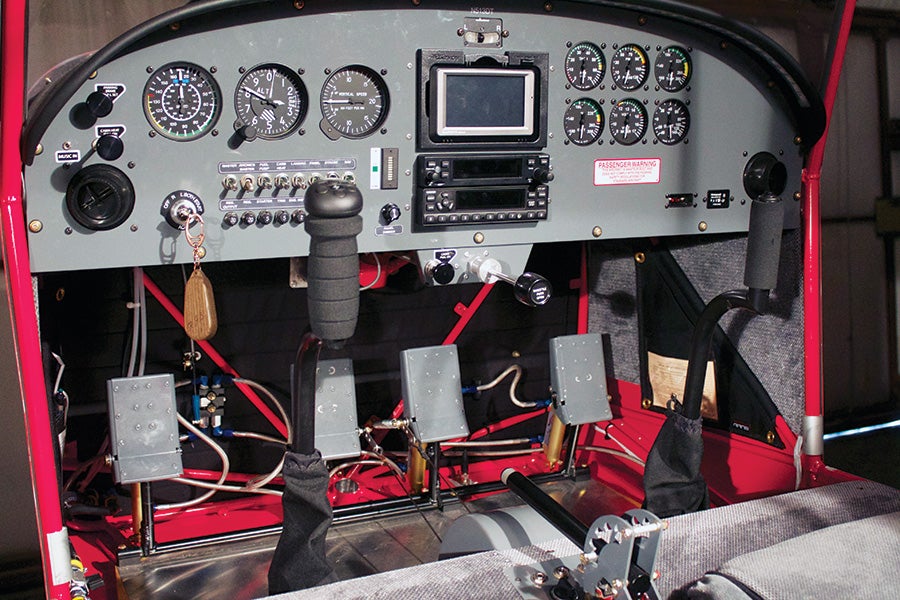
The factory demo S-20 features a basic VFR panel with a radio, transponder, and handheld Garmin aera 560 GPS. Engine instruments are separate “steam gauges.” The intercom function is built into the Garmin GTR 200 radio. Only a blank panel is included in the kit.
The S-7S, a longer version of the original S-7 design, also begs comparison with the new S-20. The S-7S is a two-place, high-wing tail dragger with tandem seating. This successful RANS design has sold almost 600 units and is a popular alternative to the Cub-like Light Sport planes on the market. It is easy to see the S-20 as a side-by-side version of the S-7S, and in a very real sense it is. But it sells the S-20 short to leave it at that. The S-20 is faster, flies better, has more baggage capacity, and is more comfortable than the S-7S. As an added bonus the S-20 can be built as a taildragger or a trike.
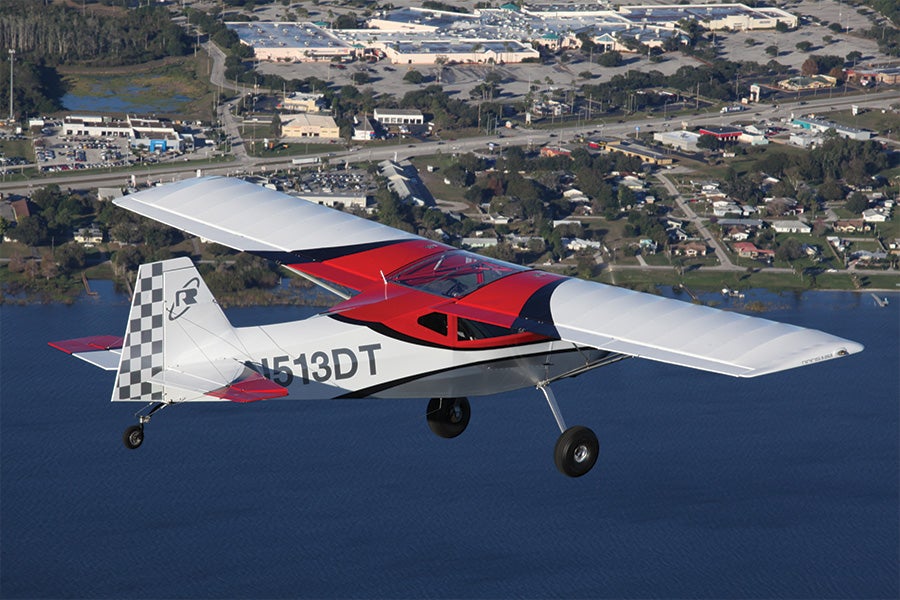
The S-20 Raven in flight shows the distinctive RANS profile made famous by the S-7S. A classic version with a rounded tail is also available on request at a small extra cost.
How Does it Fly?
No plane is worth building if it doesn’t fly well, and believe me, there are some kit aircraft out there that do not fly all that well. The S-20 is not one of them. It is easy to fly with well-harmonized controls that are light, but not too light, and overall good manners. We flew the S-20 out of Hays, Kansas (KHYS), home base for RANS Designs. If you want to be in the center of the country you are not far from it in Hays. The terrain there is pretty flat, but dotted with radio antennas, so you have to pay attention if you want to fly low. A thin layer of snow covered the countryside, but the air was a pleasant 50 F and the skies were clear—a perfect day for flying.
Taxiing the S-20 was easy enough with tailwheel steering and modest brake inputs when needed. At my height of 6 feet 3 inches and the seat pushed back accordingly, I was able to see over the nose without S-turning. Shorter pilots would benefit from having the seat farther forward, but only getting in the plane would tell if that would be enough to make up for less height.
Take-off presented few challenges, even in the taildragger version we were flying. Just put in a notch of flaps, push in the throttle, put some forward pressure on the stick to raise the tail, and by the time you see 40 mph on the airspeed indicator, you just need to ease the stick back a bit to fly. Rudder control on takeoff is good. Best rate of climb is at 60 mph, but 70 works well and gives better forward visibility. We were quickly at 2500 feet agl (4500 feet msl) where we did most of our air work.
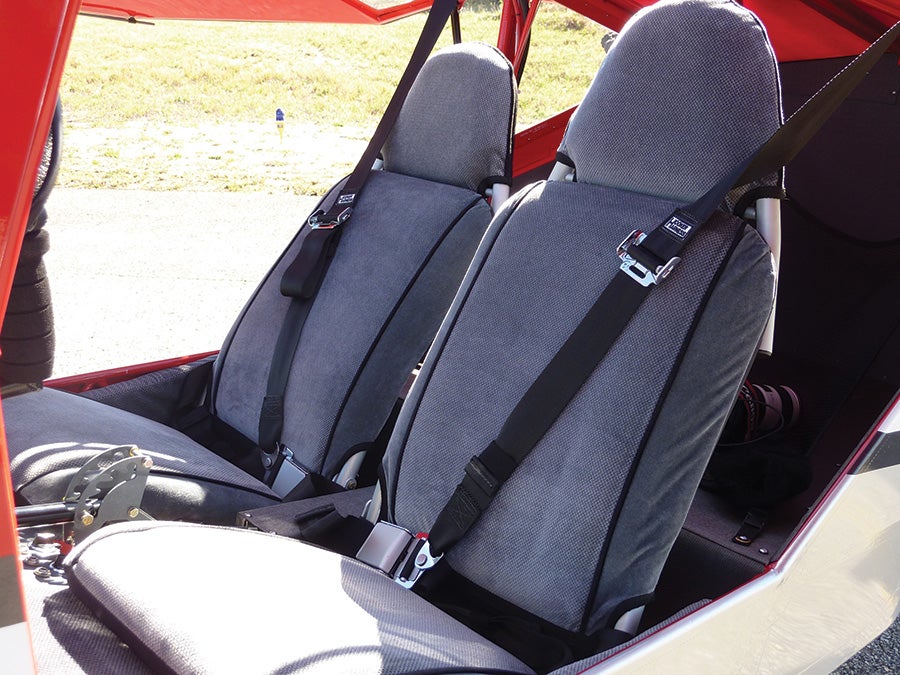
Adjustable seats fold forward to make baggage access easy. They are set on sloped tracks so they drop down as they slide back, providing more legroom and headroom for larger pilots.
I started off with a few turns, just to get the feel of the plane. The S-20 likes just a bit of rudder in the turns, but nothing out of the ordinary. It is not a flat-footed flying airplane, but I found it to need less rudder input in turns than a Cub. Holding a steady altitude in turns was quite easy and visibility was great, owing to the full-ceiling skylight above us. My sense is that the plane is fairly stable, but the glass-smooth air we flew in that day did nothing to really challenge it. At 153 square feet it has about 15% less wing area than a Cub, so it should handle the turbulence somewhat better, but any actual demonstration of that will have to wait for another day.
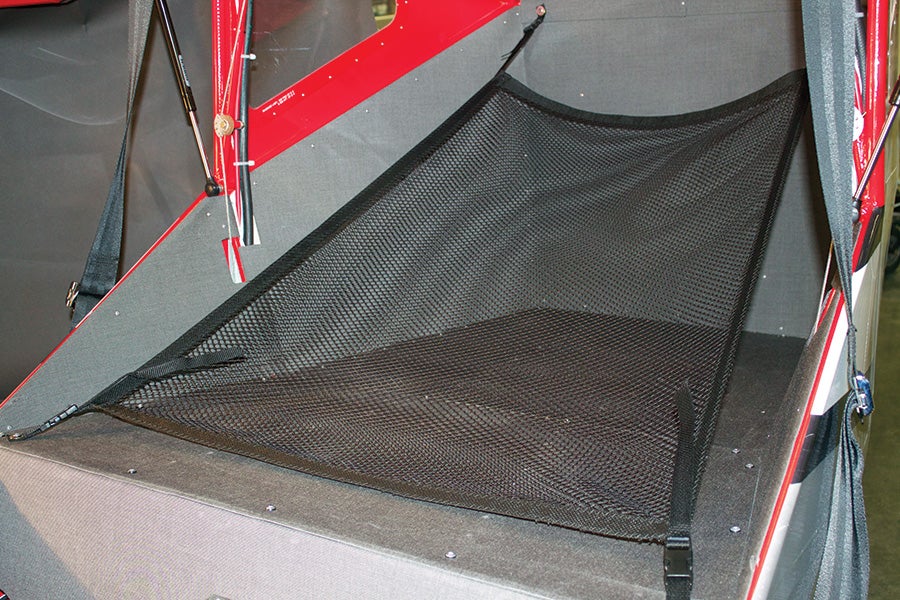
The S-20 Raven features a 21.2 cubic foot baggage area that will hold a maximum of 80 pounds. It is easily accessed by folding down the seats.
Stalls were next on the agenda. With full flaps and the power off, a pre-stall buffet occurred about two knots before the break. The actual stall break came just below 40 mph indicated and was clean and easily achieved with the powerful elevator. With power it was possible to maintain extremely high angles of attack and to see low airspeed numbers that were obviously not accurate in such a configuration. There is no doubt that an experienced pilot could really drag the S-20 in and land very short by carrying lots of power, but with the caveat that an engine failure would be followed by a very hard drop. Modest rudder inputs keep things level into the stall.
Cruise flight on such a lovely day was a real joy to behold. The plane demonstrated good stability and great visibility, holding heading and altitude with ease. A quick two-way check at 5000 feet and 5400 rpm gave us a cruise speed of about 100 knots on the Garmin GPS, which is better than the advertised 112 mph. What we did was hardly a carefully controlled test, but it looks like the book numbers are easily achievable. What is interesting is that the S-20 with its side-by-side seating is actually a bit faster than the tandem S-7S. The S-20 is just cleaner aerodynamically and has a frontal area that is almost identical to the S-7S, even though its cockpit is considerably wider. This represents some nice engineering by RANS.
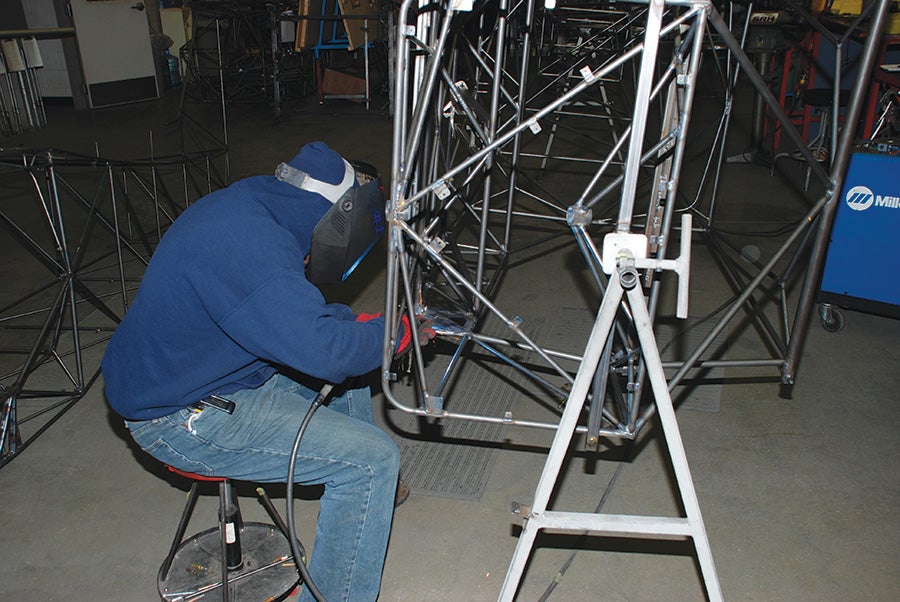
Fuselage cages are MIG welded together at the RANS factory. A rotisserie jig makes access to all welds easy.
Landings held no surprises. A final approach speed of about 60 mph with full flaps in by short final made for easy 3-point landings. With the power off it was just a matter of letting the speed bleed off after coming over the fence. A low flare point makes for better landings, as I found out after a few tries. If you pull the stick back too far during the flare and are not yet low enough, you will get a solid drop for your trouble. I expected a pretty good bounce as a result, but the gear absorbed my ham-handedness with aplomb. With a few more tries some very nice landings became routine. Wheel landings proved to be fairly easy to handle once I became familiar with the feel of the plane.
Nuts and Bolts
The S-20 is a fabric-covered high-wing design with a chromoly steel cage and aluminum wing structure. The cages are MIG welded and painted in the RANS shop, with powder coating available for an extra $1200. Some of the most critical areas are TIG welded, but Schlitter has the utmost confidence in his welding process without TIG welding the entire cage. The wings have tubular extruded spars and aluminum internal components such as ribs and cross-bracing. Wing parts are not primed before covering, except on request. Fabric is glued and riveted to the wings, so there is no rib stitching involved. Landing gear is machined out of solid aluminum and can be switched from trike to taildragger configuration with relative ease. However, the gear legs are shorter for the trike setup, so you really should have two sets of gear legs if you want to go back and forth.
RANS for many years used Dacron sail cloth to cover their planes, an obvious holdover from its ultralight origins. This covering is still available on older models, but the S-20 will be covered with Super Flite fabric. It is up to the builder to provide his or her own primer and paint. As an alternative, RANS offers the new Oratex covering system at an added cost. Oratex comes pre-painted in a number of colors and can be further painted for accents. The Oratex fabric adds about $3900 to the initial cost, but saves a lot of money in paint, especially if you are going to have someone else do the work. It also saves a great deal of time for a builder in a hurry, not to mention about 30 pounds of weight for the paint not used.
The strongest arguments against Oratex are that it does not have years and years of track record to prove its long-term durability, and the paint finish is not glossy but rather has what you might call a semi-gloss finish. RANS has also had some trouble getting a perfectly even finish on large white surfaces because of the difficulty of applying shrinking heat to it perfectly evenly. All of that said, it is still worth a look for the time and weight that it saves. A hard look at the finished product will tell you if the appearance is going to be an issue for you. The weight savings could be particularly appealing if you were thinking about upgrading to the heavier 914 engine, or if you’re like me and have not been endowed with a Light Sport body, but still want to fly Light Sport airplanes.
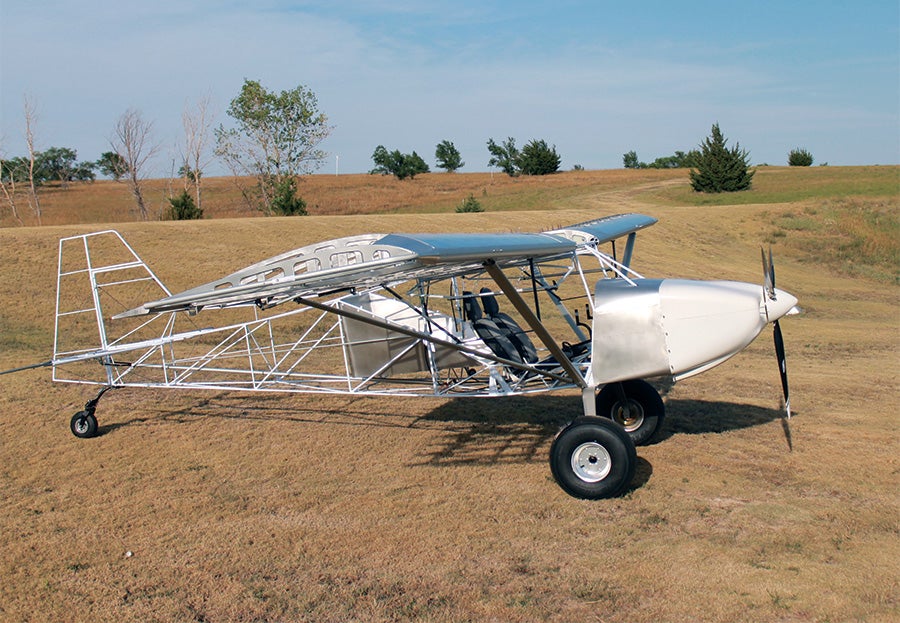
A “naked” Raven showing off its structure. The wings are all-aluminum construction and the fuselage is welded chromoly tubing. The boot cowl is also aluminum, but the engine cowl is fiberglass. A carbon-fiber cowl is available at an added cost.
What’s in the Box?
If you buy a complete kit for $25,500, you get just about everything except for the firewall-forward components, avionics, instruments, and wiring. The kit will not nickel and dime you to death with little things that are not included. Another $4500 covers the firewall-forward items except for the engine and prop. To this you may wish to add oversized tires, non-standard upholstery colors, powder coating of steel parts, and the quickbuild option that adds $9750 but cuts build time in half.
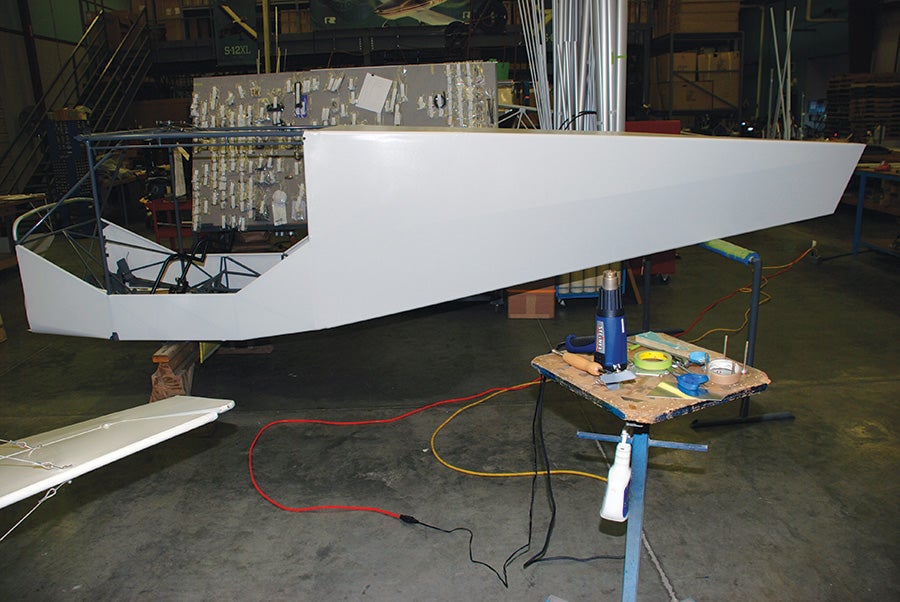
This fuselage has been covered with Oratex fabric and can go out the door without any added painting if the customer desires. This option adds cost, but saves about 30 pounds.
Engine prices are furnished on request because of the fluctuation of the Euro versus the dollar, but figure about $19,500 for a 912 ULS engine, a little over $25,000 for the fuel injected version, or $31,700 for the 914 turbocharged engine. There are enough 912 Rotax engines in service now that a used engine might be an option for you. Figure at least $10,000 for a good one and proceed with the requisite caution when buying anything that is used and expensive.
RANS recommends two propellers—the 3-blade WhirlWind or the 3-blade Warp Drive. Both are ground adjustable. Certainly other possibilities exist, but these are the ones RANS will sell you. The WhirlWind with the necessary spacer and related hardware costs $1900, and the Warp Drive runs $1145 with an add of $180 for nickel leading edges.
The kit includes a blank instrument panel, so you are on your own for instruments, avionics, and wiring. If you stick to basics and do your own work, a complete instrument panel with engine instruments, transponder, radio, and panel-mounted handheld GPS will run you about $8000. Of course, there is no upper limit to what you can spend. It would be easy to run up a tab of three or four times that amount or more, but a loaded IFR panel in such an airplane sort of misses the point of what the plane is all about.
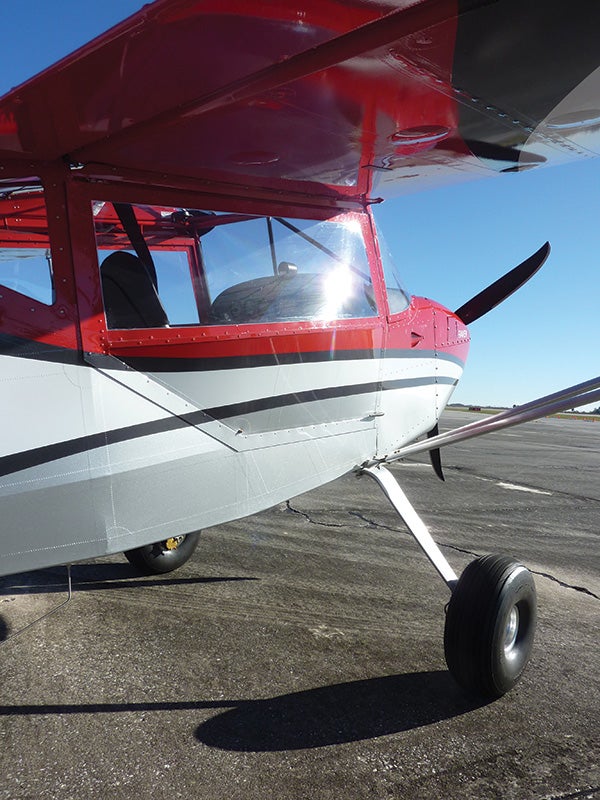
Maingear legs are solid aluminum. With two mounting positions available, it is fairly easy to convert from taildragger to trike or vice versa. However, gear legs are different for each configuration.
Builder Support
The assembly manual was not available for inspection at the time of this writing, but based on my previous examination of S-7S manuals and plans, I believe that those for the S-20 will be of superior quality. RANS support materials have received great reviews from previous builders, so there is no reason to believe they will fall short in this important respect with the Raven. RANS offers telephone support from 2 to 4 p.m. daily and will post useful information on the RANS Clan forum site when needed. With the large number of completed RANS airplanes and kits under construction, there is a good base of support for the builder group forum. Most assembly problems can be resolved on that site by posting a question or searching the archives. The value of this forum can hardly be overstated. Lack of such a group could be a pretty good reason not to purchase any kit you might be considering.
RANS produces what they call a progressive manual in that they constantly revise their materials as changes occur, rather than hold them for a reissue on a fixed date. They also contact owners and builders with service bulletins when necessary, but there have been relatively few of these.
The S-20 kit has not yet been inspected by the National Kit Evaluation Team, so compliance with the so-called 51% rule has not been verified. There is little reason to believe that this will be a problem given their experience with earlier models, but the formalities have not yet been completed. This should be remedied shortly, possibly even by the time you read this.
Another point of some interest is that RANS, despite offering an SLSA version of the Raven, will not offer the kit for construction as an ELSA. They just don’t want to deal with the extra compliance issues for planes built outside of their control. This means that Experimental/Amateur-Built will be the only reasonable choice for a builder. It will be quite easy for the builder to get a repairman certificate, but any subsequent owners will need to find a licensed A&P to do their yearly condition inspections.
Conclusion
With the waning popularity of the 2-stroke aircraft engine, the last days of airframes designed to use such powerplants are upon us. The S-6 is a great plane, but the S-20 is simply better and is designed to use the hugely popular 4-stroke Rotax 912 engine. The S-7S will remain popular, too, but many people want side-by-side seating for its obvious advantages—better for instruction, better for friendly conversation, and more baggage area. As a bonus, the S-20 is a little bit faster and handles just a little bit better. When a frugal builder can have all of this for two years’ worth of spare time and less than $60,000, you have a combination that is very appealing.
For more information call RANS at 785-625-6346 or visit their web site: www.rans.com/aircraft/kits/s-20-raven.html. For information about the RANS Clan visit www.ransclan.com. For information about Rotax engines visit www.flyrotax.com.






















thanks Dave Ben